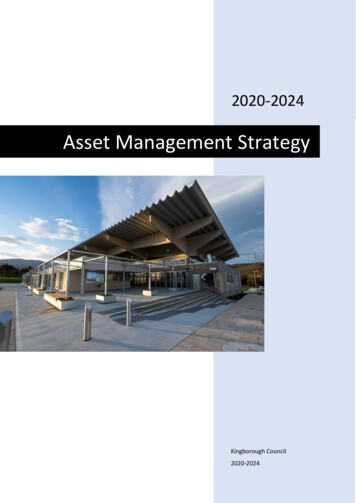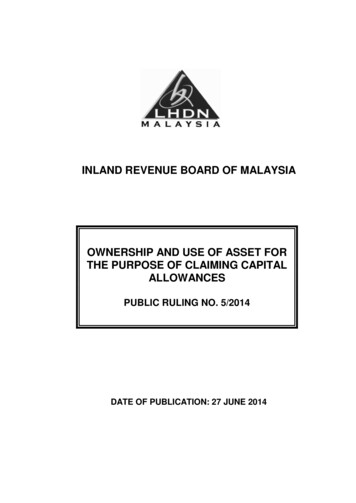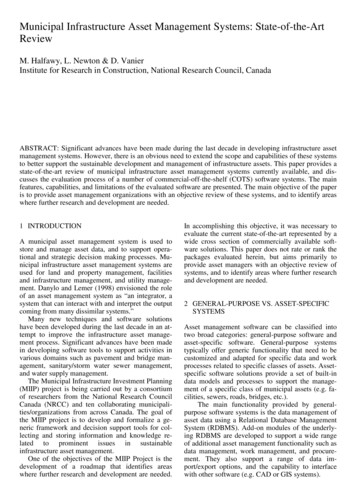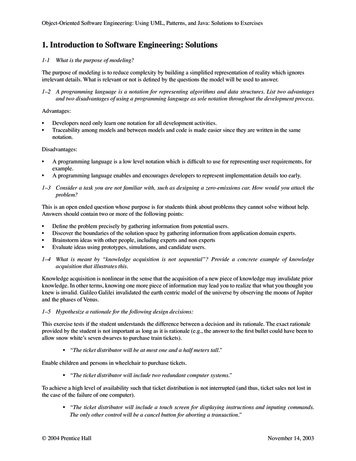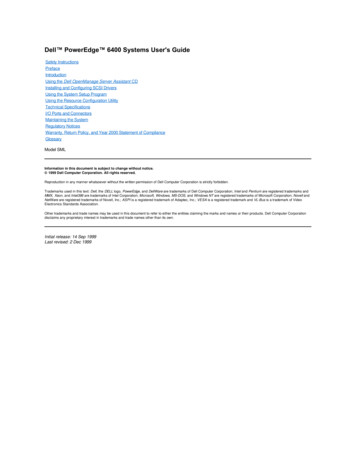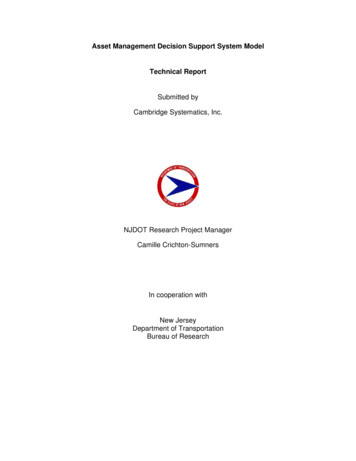
Transcription
Asset Management Decision Support System ModelTechnical ReportSubmitted byCambridge Systematics, Inc.NJDOT Research Project ManagerCamille Crichton-SumnersIn cooperation withNew JerseyDepartment of TransportationBureau of Research
DISCLAIMER STATEMENT“The contents of this report reflect the views of the author(s) who is (are) responsible forthe facts and the accuracy of the data presented herein. The contents do notnecessarily reflect the official views or policies of the New Jersey Department ofTransportation. This report does not constitute a standard, specification, or regulation.”
1. Report No.2.Government Accession No.4. Title and SubtitleTECHNICAL REPORTSTANDARD TITLE PAGE3. Recipient’s Catalog No.5. Report DateAsset Management Decision Support System Model6. Performing Organization Code7. Author(s)8. Performing Organization Report No.William Robert, Dmitry Gurenich, Jocelyn Hoffman9. Performing Organization Name and Address10. Work Unit No.Cambridge Systematics, Inc.33 E. 33rd Street, Suite 804New York, NY 1001611. Contract or Grant No.12. Sponsoring Agency Name and Address13. Type of Report and Period CoveredNew Jersey Departmentof TransportationPO 600Trenton, NJ 08625Federal Highway AdministrationU.S. Department of TransportationWashington, D.C.14. Sponsoring Agency Code15. Supplementary Notes16. AbstractThe objective of this research effort was to assist the New Jersey Department of Transportation(NJDOT) Office of Capital Investment Strategies (CIS) in developing an asset management decisionsupport model for use in its resource allocation decisions. This effort both integrates with and builds offof NJDOT’s existing asset management program.Best practices in asset management were first reviewed followed by an assessment of assetmanagement systems currently in place at NJDOT. These findings helped the research teamformulate an appropriate decision support model that would inform NJDOT’s project prioritizationstrategy and assist the NJDOT in its cross-asset resource allocation decisions.The result of this research effort is an asset management decision support model that calculates theutility for a user-specified project. The model specifies how NJDOT should use asset managementdata and systems to support integrated high-level resource allocation decisions and also focuses onhow to use available data to prioritize identified problems (also termed “candidate projects” or “projectalternatives” in this report), as well as planned projects.17. Key Words18. Distribution Statement19. Security Classif (of this report)20. Security Classif. (of this page)UnclassifiedUnclassified21. No of Pages58Form DOT F 1700.7 (8-69)i22. Price
ACKNOWLEDGEMENTSThe researchers acknowledge the New Jersey Department of Transportation Office ofCapital Investment Strategies for its generous support of this research.ii
TABLE OF CONTENTSPageEXECUTIVE SUMMARY . 1BACKGROUND . 2OBJECTIVES . 3INTRODUCTION . 4SUMMARY OF WORK PERFORMED. 5Existing Practice Review . 5Literature Review . 5Existing Practice Examples . 7Agency Profiles . 13NJDOT Asset Management Systems . 19Asset Management Decision Support Model Development . 20Utility Function . 21Concept of Utility. 21Recommended Utility Function. 27Optimization Model . 30The Capital Budgeting Problem . 30Model Formulation . 31Solution Approaches . 33Use of the Model for Decision Support . 35Support for Ranking . 33Applying Optimization Results . 36Required System Functionality . 37CONCLUSIONS . 44APPENDIX A – METIS WORKSHOP SUMMARY. 45APPENDIX B – UTILITY FUNCTION PARAMETERS . 52LIST OF FIGURESPageFigure 1. VDOT Dashboard . 8Figure 2. AssetManager NT . 9Figure 3. Utah DOT dTIMS Objective Weights . 10Figure 4. Arizona DOT Maintenance Budgeting System . 12Figure 5. Georgia DOT Project Prioritization . 13Figure 6. Project List . 38Figure 7. Project List – Sorted . 39Figure 8. Project Detail – Mobility/Pavement . 40Figure 9. Project Detail – Bridge . 40Figure 10. Optimization Configuration . 42Figure 11. Analysis Summary Results. 43Figure 12. Analysis Summary Graph. 43LIST OF TABLESPageTable 1. Asset Management Practices in Selected States . 15iii
EXECUTIVE SUMMARYAllocating limited resources across investment categories (e.g., preservation versuscongestion management) is a challenge faced by state transportation departmentsacross the nation. The objective of this research effort was to assist the New JerseyDepartment of Transportation (NJDOT) Office of Capital Investment Strategies (CIS) indeveloping an asset management decision support model for use in its resourceallocation decisions. This effort both integrates with and builds off of NJDOT’s existingasset management program.Best practices in asset management were first reviewed followed by an assessment ofasset management systems currently in place at NJDOT. These findings helped theresearch team formulate an appropriate decision support model that would informNJDOT’s project prioritization strategy and assist the NJDOT in its cross-asset resourceallocation decisions.The result of this research effort is an asset management decision support model thatcalculates the utility for a user-specified project. The model specifies how NJDOTshould use asset management data and systems to support integrated high-levelresource allocation decisions and also focuses on how to use available data to prioritizeidentified problems (also termed “candidate projects” or “project alternatives” in thisreport), as well as planned projects.As a next step, the research team recommends that NJDOT test the model using actualproject data. This would entail using the model to calculate utilities for candidateprojects, test the ranking of projects, and solve the project-level optimization modelformulated in the document on trial basis. Implementing the asset managementdecision support model detail here in theory should help NJDOT better prioritizeprojects in a manner that is consistent with agency goals and objectives, improve costeffectiveness, and ultimately lead to an improved transportation system.1
BACKGROUNDThe New Jersey Department of Transportation (NJDOT) faces a significant set ofchallenges with respect to determining what investments to make in its transportationsystem. New Jersey’s transportation network is extensive and well-developed. TheState’s transportation assets, including its roads, bridges, and other elements of itstransportation infrastructure, are in widely varying condition, and have a vast range ofneeds. The available funds for transportation are not sufficient for supporting all of theneeds that have been identified for preserving and improving the transportation network.Thus, NJDOT is challenged to balance investments in different asset and investmentcategories to best preserve the State’s transportation network, while making targetedimprovements in mobility, safety and other areas.Transportation asset management – defined as a “strategic approach to managingtransportation infrastructure” – provides a framework that enables NJDOT to manage itstransportation network more effectively. NJDOT is interested in implementing assetmanagement concepts to make the best possible use of available transportationfunding, in support of the Department’s objectives. To this end NJDOT’s Office ofCapital Investment Strategies (CIS) has embarked on an asset management program,assessed its existing asset management systems, and begun the process of integratingits asset management data. As part of this effort NJDOT tasked CambridgeSystematics (CS) and its subcontractor Howard Stein Hudson (HSH), with thedevelopment of an asset management decision support model for use in supportingresource allocation decisions. This report details the results of that effort.2
OBJECTIVESThe basic objectives of the research described in this report are as follows: Research best practices in asset management, present options for NJDOT toconsider for an Asset Management Decision Support Model. Examine NJDOT management systems and the decision making/prioritizationalgorithms, as well as how the outputs of these are used.Based on the review of best practices and NJDOT systems, develop logicalmodels/algorithms for allocating NJDOT resources, prioritizing problems and projects,and optimizing project timing.3
INTRODUCTIONThis report details the results of the research effort for NJDOT. The project wasperformed through the set of tasks detailed below.Existing practice review: for this task the research team reviewed current assetmanagement practices, systems, and tools in use at other U.S. transportation agenciesand identify elements applicable to New Jersey.Asset management systems review: this task focused on review of existing andplanned systems for supporting asset management at NJDOT and identification ofsystem needs to be addressed in the development of a decision support model.Model development: After reviewing existing practices and NJDOT staff, the researchteam developed an asset management decision support model that specifies howNJDOT should use asset management data and systems to support integrated highlevel resource allocation decisions. The model development effort specifically focusedon how to use available data to prioritize identified problems (also termed “candidateprojects” or “project alternatives” in this report), as well as planned projects.Asset management workshop: initially a workshop was planned at the end of theproject to communicate the asset management decision support model to NJDOTmanagers and staff. Over the course of the research, the emphasis of the workshopshifted from reviewing the conclusions of the research to walking through an exercise ofprioritizing NJDOT investments at a high-level, which provided key input to the decisionsupport model.Implementation support: for this task the research team provided additional support inimplementing the decision support model, and performing other activities not otherwiseincluded in the scope of the other tasks.4
SUMMARY OF WORK PERFORMEDExisting Practice ReviewThis section provides background information on existing asset management practices,systems, and tools in use at targeted transportation agencies in the U.S., and discusseskey management systems used by NJDOT.The review considered approaches for prioritizing resource allocation investments,including practices, systems, and tools that support integrated pavement, bridge, andsafety investment decisions. The review focused on examples of other U.S. statetransportation departments that have developed tools and approaches for integratingresource allocation decisions for multiple asset types.Literature ReviewInformation on existing practices was compiled through a targeted literature review, andbased on research team experience. The literature consulted was not intended to beexhaustive, but rather instructive of the practices, information, systems, and decisionsupport tools that currently are being used by transportation agencies to support assetmanagement, specifically in the areas of pavement, bridge, mobility and safety. Currentliterature in the field applicable to the NJDOT effort included: National Cooperative Highway Research Program (NCHRP) Report 632: An AssetManagement Framework for the Interstate Highway System (2009) describes anasset management approach for managing interstates. It includes a comprehensivereview of highway asset management data, tools, and performance measures. Transportation Research Board (TRB) Circular E-C131: Transportation AssetManagement Strategic Workshop for Department of Transportation Executives(2008) describes the results of an international scan of asset management practices,documents a workshop on asset management attended by a set of state departmentof transportation (DOT) executives, and presents numerous examples of existingpractices. U. S. Domestic Scan Program: Best Practices in Transportation Asset Management(2007) details the results of a domestic scan of asset management practiceperformed as part of NCHRP Project 20-68. NCHRP Report 551: Performance Measures and Targets for Transportation AssetManagement (2006) details performance measures used for asset management,describes how performance measures can be used to support decision-making, andpresents a framework for performance measure development.5
NCHRP Report 545: Analytical Tools for Asset Management (2005) reviews assetmanagement tools and systems, and details the development of a set of two tools,AssetManager NT and PT, for supporting resource allocation. American Association of State Highway and Transportation Officials (AASHTO)Transportation Asset Management Guide (2002) details basic principles of assetmanagement, presents an approach to assessing an organization’s assetmanagement approach, and presents a series of best practice examples.These documents provided not only the basis for selecting representative best practiceexamples, but a foundation for how an asset management decision support model couldbe applied to NJDOT.A common perspective underscores all of the literature, best summarized in theAASHTO Transportation Asset Management Guide. As described in the guide, assetmanagement is a strategic approach to managing transportation infrastructure. Morespecifically, asset management helps agencies to get the best results/performance forthe preservation, improvement, and operation of infrastructure assets given availableresources.Basic asset management principles are: Policy Driven – decisions reflect policy goals and objectives Performance Based – Performance measures are defined and target values areestablished Options Evaluated – comprehensive choices and tradeoffs are examined at eachlevel of decision-making Decisions Based On Quality Information – management systems and toolssupport decision makers Clear Accountability – performance results are monitored and reportedThe overall benefits of asset management can be grouped into two discrete categories: Performance and cost effectiveness – deliver policy goals and objectives; lowerlong-term costs for infrastructure preservation; improved performance and service tocustomers; and improved use of available resources. Communication, accountability, and credibility – improved communication withinagency and with customers; and improved credibility and accountability fordecisions.In addition to promoting a common perspective on what asset management is, thedocuments reviewed share a common perspective on why it is important. Namely, thereality of transportation management today is that state DOTs are required to do more6
with less, as available funds are not sufficient to support all of the preservation andimprovement needs a DOT may wish to fund. One aspect of effectively managing thetransportation network is balancing investments across different asset categories toboth preserve the system and implement targeted improvements. Resource allocationinformed by asset management concepts provides an opportunity to prioritize needsand better inform decision-making with respect to allocating funds across assetcategories.Existing Practice ExamplesExisting practices have been summarized with particular attention to four areas withinasset management of greatest relevance to development of an asset managementdecision support model for NJDOT. These include: Performance measure reporting; Cross-asset resource allocation; Maintenance budgeting; and Project ranking.For each of these areas, the following discussion summarize best practices, andpresent one or more examples of how other state DOTs currently are addressing theidentified area.Performance Measure Reporting. Performance measures have received a great dealof attention in recent years, and the recent emphasis on performance measures is onlylikely to increase with the next transportation reauthorization bill. Establishing a set ofperformance measures for characterizing asset conditions is an important first step inimplementing an asset management approach. Once an agency has established a setof measures, the next step is to track performance over time, and begin to setperformance targets, using this information for high-level budgeting. Further, an agencymay provide information on performance trends for internal or external use.A number of state DOTs have developed reports, report cards, and other approachesfor communicating target and actual performance. Of particular note, theCommonwealth of Virginia developed the Virginia Performs initiative, which promotestransparency by tracking performance measures for each state agency. The initiative isdesigned to align specific state agency outcomes with larger statewide goals. As part ofthis effort Virginia DOT developed an interactive performance dashboard. Widelyrecognized as an effective performance reporting tool, the dashboard rolls up real-timeor near-time performance information into easy to understand graphics. Summaryinformation is provided for key measures covering pavement and bridge condition,roadway safety, highway congestion, and agency performance (e.g., project delivery).An example of the performance dashboard is shown below in Figure 2.2.7
Source: Virginia DOT.Figure 1. VDOT DashboardCross-Asset Resource Allocation. Determining how to allocate funds between assetor investment types is a fundamental challenge in asset management. Typicallyagencies have pavement and bridge management systems that recommend fundinglevels and projects specifically for those assets, and they have a variety of other typesof investment needs that may or may not be supported by a management system.One can envision an ideal asset management system that performs both the asset-levelanalysis that existing management systems perform, and that considers how best tooptimize between asset/investment categories. In practice, systems that combineasset/investment categories tend to either use pretabulated results from othermanagement systems, or simplify the problem, performing a less detailed analysis thanthat performed by other asset-specific management systems. Thus, documents thatprovide guidance, such as NCHRP Report 551, tend to focus on approaches to usingbest-of-breed management systems, with additional processes or analyses, to supportcross-asset decision-making.Given the state of existing systems, a common approach to making cross-assetallocation decisions is to use asset/investment-specific systems to predict theperformance that will result from a given budget level, and then comparing theperformance of different funding allocations in terms of their impact on selectedperformance measures. In fact, this the basic approach CIS follows in developing itsbudgeting.Several state DOTs have implemented the AssetManager NT tool for supporting such aprocess. AssetManager NT is designed to integrate results from multiple managementsystems to facilitate what-if analysis. The end user can configure what data are to be8
imported, what measures to display, and how funds are distributed (e.g., by district,region, or other groupings). The system can then display, for a given overall budgetand allocation between assets, the predicted performance of the system over time.This tool is detailed in NCHRP Report 545. Following its initial development throughNCHRP, AASHTO incorporated the tool in its AASHTOWare program, and, through thisprogram, the tool was implemented in approximately 10 agencies.Figure 2.3 shows an example screen from AssetManager, in this case configured withdata from South Carolina DOT for NCHRP Project 20-74. Here the system is usingresults from South Carolina DOT’s pavement and bridge management systems, as wellresults from runs of the Federal Highway Administration (FHWA) Highway EconomicsRequirements System (HERS) to simulate mobility improvements. The screen showspredicted performance for six measures, including pavement and bridge conditions,delay, crash costs and overall user costs. These are projected for three different budgetallocations (each plotted as a separate series). The budget allocations are specified atthe bottom of the screen.Source: NCHRP Report 632.Figure 2. AssetManager NTThere are a number of examples of agencies, including NJDOT, that either useAssetManager, or perform similar analyses through manual or spreadsheet approaches.As noted above, all of these rely on data from external systems, such as a pavementand bridge management system. Less common are approaches that perform integratedanalysis within a single system. The review yielded two such examples operating in a9
production environment (versus as a research effort): Utah DOT and New BrunswickDOT.Utah DOT utilizes the Deighton dTIMS system to model pavement and bridgeinvestment needs. dTIMS was originally designed as a pavement management system,but Deighton has extended the system such that it can support analysis of other assettypes. In Utah DOT’s case, the system already was being used as the agency’spavement management system. Utah DOT added bridges to dTIMS. Though thebridge modeling in dTIMS is more rudimentary than that supported by the agency’sbridge management system (Pontis), Utah DOT concluded it was nonetheless sufficientfor high-level resource allocation decisions. In using dTIMS, Utah DOT allocates fundsbetween pavement and bridges on the basis of remaining service life, with adjustmentsbased on a variety of factors. Figure 2.4 shows the factors Utah DOT has established.New Brunswick DOT has established a cross-asset resource allocation process using adifferent approach. The agency uses the Remsoft Woodstock model for performing along-term optimization of pavement and bridge needs. This model was originallyintended to optimize investments in the forestry industry, but has been adapted toincorporate pavement and bridge deterioration models to optimize project selectionsbetween asset categories over a 100-year period. This approach also provides a leastlife cycle cost solution for pavement and bridge preservation.Source: Utah DOT.Figure 3. Utah DOT dTIMS Objective WeightsMaintenance Budgeting. Though asset management ostensibly addresses the fullrange of assets and investment types of interest to a DOT, in practice, much of the10
focus in this area has been on pavement and bridges. There are examples of systemsand sketch planning tools for analyzing other assets/investment types, particularly withregard to mobility and safety investments, but relatively few examples of workingsystems that perform functions such as recommending funding levels or predictingfuture performance. The review focused on the area of maintenance budgeting (alsotermed “maintenance levels of service” or “maintenance quality assurance”) as this isthe most common analytical approach used for analyzing investment needs for otherphysical assets besides pavement and bridges, and may be of relevance to NJDOT.Maintenance budgeting is used to establish a target level of performance for a DOT’smaintainable assets, such as paved surfaces, shoulders, roadside assets, and restareas. Generally, the conditions of these assets are characterized using a level ofservice (LOS) description (often expressed using letter grades), and the approachresults in a prediction of the level of funding required to maintain a specified LOS. Tosupport the approach, the agency typically collects sample data on existing LOS, suchas through conditions at some number of randomly selected sites on an annual basis.Maintenance budgeting has been used by a number of states to help establish anappropriate level of funding for maintenance, but is not intended to support analysis ofcapital projects.Arizona’s implementation of maintenance budgeting is representative of the state-ofthe-practice. Arizona DOT uses a maintenance budgeting system for implementing theapproach described above, relating maintenance expenditures to asset conditions, withLOS defined by letter grades (A through F). A web-based application, depicted inFigure 2.5, has been developed to store data on LOS, and explore trade-offs inmaintenance budgeting. With the system, the agency can determine the fundingrequired to achieve a certain level of performance, or alternatively, view the impact of agiven level of funding.11
Source: Arizona DOT.Figure 4. Arizona DOT Maintenance Budgeting SystemProject Prioritization. Given the focus of the research effort, this area is of particularrelevance to NJDOT. The review identified a number of examples of projectprioritization approaches. Generally speaking, most examples in this area are caseswere an agency has developed an approach to calculating a score for some set ofpreviously identified set of projects – often mobility projects considered for a state’sTransportation Improvement Plan (TIP). Typically scoring is used where there is nomanagement system available and/or where there are subjective elements to theprocess that would not be well-supported by the available systems, even if they wereimplemented. Less common are examples of scoring pavement or bridge preservationwork, or calculating scores across all of an organization’s investment types.Georgia DOT’s experience is typical of the state-of-the-practice. Recently Georgia DOTinitiated an effort to improve its approach to project prioritization. Working withCambridge Systematics Inc., the agency developed an approach that adapts modelsfrom HERS to predict direct transportation benefits for capacity expansion projects. Ascore is then computed for each project, combining benefit measures with othernoneconomic measures and a set of agency-specified weights. The approach wasimplemented using a web-based system, as shown in Figure 2.6. The approach isnotable in its adaptation of the HERS models for predicting a set of quantitativemeasures that can be used for prioritization, and for its ability to accommodate different12
weighting approaches, such as a Georgia DOT weighting approach, and alternativeapproaches specified by Metropolitan Planning Organizations (MPOs).Figure 5. Georgia DOT Project PrioritizationA general issue with the approaches that have been implemented for projectprioritization is that there is often a desire to simplify the myriad of data on a project tosingle score. However, even if one can reach consensus within an agency with regardto how to compute that score, it is often unclear what one is to do with it. In a worldwithout budget or other constraints, an agency would presumably focus on its highestscoring projects, but it is the problem constraints (e.g., funding by district or region,agreements on local distribution of funds, issues such as project readiness) that oftendrive decisions. Given this issue, project scores or priorities, when computed, are oftenused as information that assists decision-making, but are by no means authoritative. Incases such as Georgia DOT, the score is often displayed along with a matrix of otherquantitative and
Management Framework for the Interstate Highway System (2009) describes an asset management approach for managing interstates. It includes a comprehensive review of highway asset management data, tools, and performance measures. Transportation Research Board (TRB) Circular E-C131: Transportation Asset
